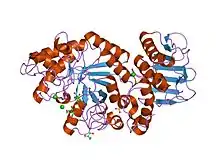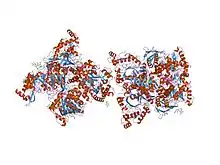Glycoside hydrolase family 20
In molecular biology, glycoside hydrolase family 20 is a family of glycoside hydrolases.
| Glycosyl hydrolase family 20, catalytic domain | |||||||||
|---|---|---|---|---|---|---|---|---|---|
 wildtype streptomyces plicatus beta-hexosaminidase in complex with product (glcnac) | |||||||||
| Identifiers | |||||||||
| Symbol | Glyco_hydro_20 | ||||||||
| Pfam | PF00728 | ||||||||
| Pfam clan | CL0058 | ||||||||
| InterPro | IPR015883 | ||||||||
| SCOP2 | 1qba / SCOPe / SUPFAM | ||||||||
| CAZy | GH20 | ||||||||
| CDD | cd02742 | ||||||||
| |||||||||
| Glycosyl hydrolase family 20, domain 2 | |||||||||
|---|---|---|---|---|---|---|---|---|---|
 crystallographic structure of human beta-hexosaminidase a | |||||||||
| Identifiers | |||||||||
| Symbol | Glyco_hydro_20b | ||||||||
| Pfam | PF02838 | ||||||||
| InterPro | IPR015882 | ||||||||
| SCOP2 | 1qba / SCOPe / SUPFAM | ||||||||
| CAZy | GH20 | ||||||||
| |||||||||
Glycoside hydrolases EC 3.2.1. are a widespread group of enzymes that hydrolyse the glycosidic bond between two or more carbohydrates, or between a carbohydrate and a non-carbohydrate moiety. A classification system for glycoside hydrolases, based on sequence similarity, has led to the definition of >100 different families.[1][2][3] This classification is available on the CAZy web site,[4][5] and also discussed at CAZypedia, an online encyclopedia of carbohydrate active enzymes.[6][7]
Glycoside hydrolase family 20 CAZY GH_20 comprises enzymes with several known activities; beta-hexosaminidase (EC 3.2.1.52); lacto-N-biosidase (EC 3.2.1.140). Carbonyl oxygen of the C-2 acetamido group of the substrate acts as the catalytic nucleophile/base in this family of enzymes.
In the brain and other tissues, beta-hexosaminidase A degrades GM2 gangliosides; specifically, the enzyme hydrolyses terminal non-reducing N-acetyl-D-hexosamine residues in N-acetyl-beta-D-hexosaminides. There are 3 forms of beta-hexosaminidase: hexosaminidase A is a trimer, with one alpha, one beta-A and one beta-B chain; hexosaminidase B is a tetramer of two beta-A and two beta-B chains; and hexosaminidase S is a homodimer of alpha chains. The two beta chains are derived from the cleavage of a precursor. Mutations in the beta-chain lead to Sandhoff disease, a lysosomal storage disorder characterised by accumulation of GM2 ganglioside.[8]
References
- Henrissat B, Callebaut I, Fabrega S, Lehn P, Mornon JP, Davies G (July 1995). "Conserved catalytic machinery and the prediction of a common fold for several families of glycosyl hydrolases". Proceedings of the National Academy of Sciences of the United States of America. 92 (15): 7090–4. Bibcode:1995PNAS...92.7090H. doi:10.1073/pnas.92.15.7090. PMC 41477. PMID 7624375.
- Davies G, Henrissat B (September 1995). "Structures and mechanisms of glycosyl hydrolases". Structure. 3 (9): 853–9. doi:10.1016/S0969-2126(01)00220-9. PMID 8535779.
- Henrissat B, Bairoch A (June 1996). "Updating the sequence-based classification of glycosyl hydrolases". The Biochemical Journal. 316 (Pt 2): 695–6. doi:10.1042/bj3160695. PMC 1217404. PMID 8687420.
- "Home". CAZy.org. Retrieved 2018-03-06.
- Lombard V, Golaconda Ramulu H, Drula E, Coutinho PM, Henrissat B (January 2014). "The carbohydrate-active enzymes database (CAZy) in 2013". Nucleic Acids Research. 42 (Database issue): D490–5. doi:10.1093/nar/gkt1178. PMC 3965031. PMID 24270786.
- "Glycoside Hydrolase Family 20". CAZypedia.org. Retrieved 2018-03-06.
- CAZypedia Consortium (December 2018). "Ten years of CAZypedia: a living encyclopedia of carbohydrate-active enzymes" (PDF). Glycobiology. 28 (1): 3–8. doi:10.1093/glycob/cwx089. PMID 29040563.
- Bolhuis PA, Ponne NJ, Bikker H, Baas F, Vianney de Jong JM (September 1993). "Molecular basis of an adult form of Sandhoff disease: substitution of glutamine for arginine at position 505 of the beta-chain of beta-hexosaminidase results in a labile enzyme". Biochimica et Biophysica Acta (BBA) - Molecular Basis of Disease. 1182 (2): 142–6. doi:10.1016/0925-4439(93)90134-m. PMID 8357844.